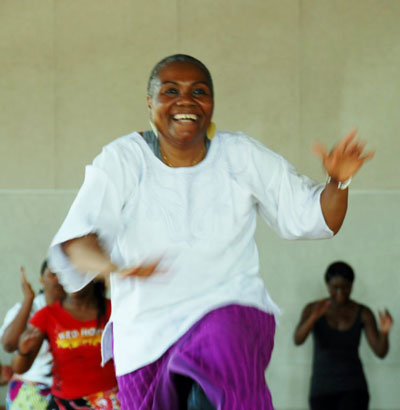 “Because dance is inseparable from a sense of community, I tell my kids that an individual shines because the community shines.”
“Because dance is inseparable from a sense of community, I tell my kids that an individual shines because the community shines.”
— Naomi Washington Diouf
Editor’s Intro: The word on the dance circuit for those of us who partake in the rich African arts scene in Oakland is that taking classes with Diamano Coura West African Dance Company is like being part of a family. Papa Zak and Mama Naomi are the affectionate names given to Dr. Zakariya Diouf and Naomi Washington Diouf, master artists from Senegal and Liberia, respectively, and the directors of an active performing company. Having made California their home for over three decades, the couple have trained and toured the world with the national ballets of their countries before settling in the West. Here they have trained hundreds of dancers and drummers through their studio instruction, master workshops, and high school and college level classes. It is through their pioneering and persistent efforts that the Dioufs are considered as elders by many African nationals who are teaching artists throughout the United States in a current renaissance of African arts. Each year, a program known as Collages des Cultures Africaines brings together master artists and local artists to take classes, make art, and perform together.
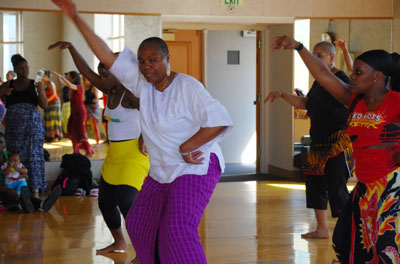 The familial titles of Mama and Papa that Naomi Diouf and her husband, Zak enjoy are not only an affectionate testimony to the relationships they create, but also suggest an authority and responsibility towards others. With a long history of teaching in the Bay Area, we explored with Naomi Diouf how teens are impacted by the learning of traditional arts.
The familial titles of Mama and Papa that Naomi Diouf and her husband, Zak enjoy are not only an affectionate testimony to the relationships they create, but also suggest an authority and responsibility towards others. With a long history of teaching in the Bay Area, we explored with Naomi Diouf how teens are impacted by the learning of traditional arts.
“Every age is critical,” began Naomi Diouf, gesturing widely and creating a circle with her arms. It was both an embrace and a circle complete. For a woman who was identified at 10 years of age as an exemplary dancer set to train for the national ballet company of Liberia, she knows well the rigor, sacrifice, and practice of dance as a calling. “Life lessons are built into the learning of dance,” she says reflecting on the years spent with her mentors and fellow artists who became her support system and her family.
The family-as-community model is the foundation she brings into her classroom. “The way we start is to build community.” She refers easily to her students as “my kids,” identifying that a key feature of development for teens is the constant negotiations between peers and the parental voice. Youth enter a classroom and project to one another. The heavy competition to please peers can be overpowering. It is at this juncture that Naomi emphasizes, “You have to remember where you come from and remember what your tradition is and who your parents are.” She actively creates these linkages of family and lineage through her teaching methods. Her tools are embedded in the arts practice itself.
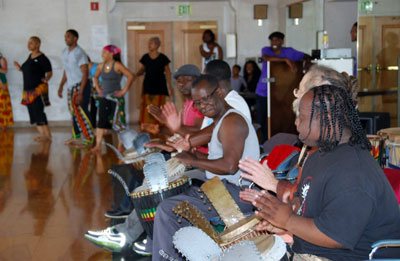
The dances she teaches are informed by their context which becomes the springboard for multiple learning opportunities. For example, the learning of an ethnically-specific dance and drum style is also a window into history and geography; a dance narrative provides a world view into a life-cycle event such as the rites of passage for young men and women into adulthood; a harvest dance provides a commentary on the cycles of seasons; mythical stories provide a moral lesson on wrong and right. The understanding of context is critical because without it, the performance has little meaning beyond creating stage pictures. Through this understanding, the physicality of the dance takes on a meaning that is both personal for the young artist yet relates to something much larger than a single person.
This learning environment contributes to a backdrop of stability for teens whose identity formation is in active flux. One degree of success can be measured by the strong number of Diamano Coura students who first encountered Naomi through her classes at Berkeley High School. With over 400 teens having access to her teaching annually,a number of them continued their studies at a more advanced level after graduating by first apprenticing with the Diamano Coura West African Dance Company. Fifteen years later, these same students are now the active next generation of artists, teachers, producers, and choreographers, while still performing with Mama Naomi. The artistic lineage through the practice is alive and well in the Bay Area through this next generation, many of whom are actively involved transnationally as well. “It is my pride and joy for people to carry on and create their own companies or to choose dance as a career,” she beams. “They carry the message.” Several of the seven Diouf children are active dancers and drummers having grown up in the studio with their parents.
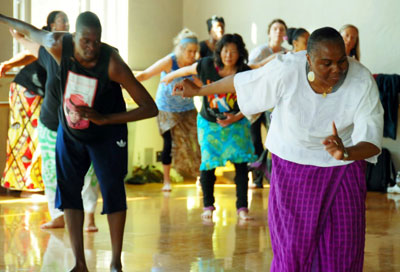
Reflecting on her own teenage years, Naomi pauses before smiling and saying that those years were “not so different.” There was rebellion and pushing of boundaries, she recalls, but the difference between being raised in Liberia and what she encounters here in the U. S. is that respect for elders was instilled very early on in their lives. Corporeal punishment could be meted out for young offenders if needed to keep social order. “Guilt,” she continues was there to “put you back in line, as was the church and so many adults who looked out at you all over town.” As a young woman, the interaction of multiple generations was a given. She went through a rite of passage in her teen years along with others in her community at the onset of menses. Older women acted as mentors, advising the young women about life. “It helped us to have good, strong self-identities. We had guidance all the way.”
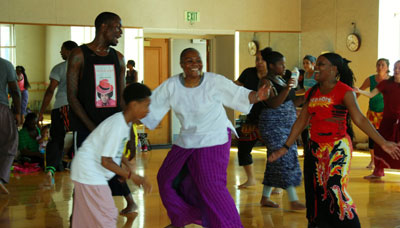 As a California-based mentor and master artist, Naomi Diouf is an exacting authority figure. “I drive my students. My standards are high. I have a syllabus and a technique. I assess my students and ask them to self-assess. I videotape them and ask them to see other professional companies to learn how to evaluate what they are doing.” What she strives to demonstrate to her family of students and to the wider public is that the study of traditional West African dances is no less demanding than the study of ballet. “In the village we were trained performers. We trained three times a day on sand. We had rigor and stamina and were driven very hard in our training to be the best,” she comments. The problem is that the value of this training is not acknowledged compared to how ballet training is heralded. Naomi lists the various values of traditional African dance study, including: it requires complex thinking, multi-tasking, the study of anatomy and physiology; it provides structure and organization which circles back to real life lessons for any teen engaged in arts and academics.
As a California-based mentor and master artist, Naomi Diouf is an exacting authority figure. “I drive my students. My standards are high. I have a syllabus and a technique. I assess my students and ask them to self-assess. I videotape them and ask them to see other professional companies to learn how to evaluate what they are doing.” What she strives to demonstrate to her family of students and to the wider public is that the study of traditional West African dances is no less demanding than the study of ballet. “In the village we were trained performers. We trained three times a day on sand. We had rigor and stamina and were driven very hard in our training to be the best,” she comments. The problem is that the value of this training is not acknowledged compared to how ballet training is heralded. Naomi lists the various values of traditional African dance study, including: it requires complex thinking, multi-tasking, the study of anatomy and physiology; it provides structure and organization which circles back to real life lessons for any teen engaged in arts and academics.
Teaching African dance is telling a story of culture, Naomi reminds us. It is both an idealized version of that culture and reflects reality. In 2007, the Diamano Coura West African Dance Company performed a staged work choreographed by Naomi, specifically addressing the role of children and teens. In this work, the subject was the use of child soldiers who were forced to carry out atrocities unspeakable to the imagination in the protracted Liberian civil war. “To understand child soldiers everywhere, we had to bring it to the stage. Our Oakland kids understood this in their own way accessing their own urban experience with guns and tragedy in our own communities,” Naomi reflected. As a tool of relevance, the traditional dance vocabulary provided a dynamic volley between the past and the present to make commentary on a complex issue.
—————————————————————————-
Naomi Diouf appears in the beginning segment of the following clip, with members of the Diamano Coura West African Dance Company.
